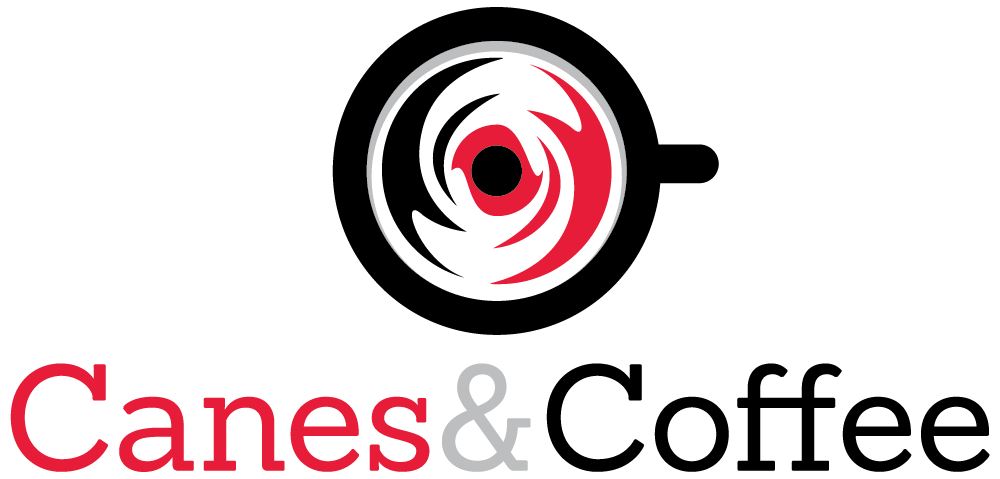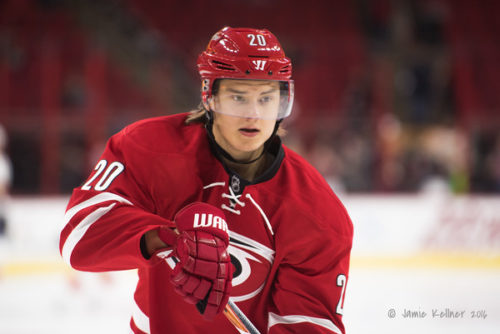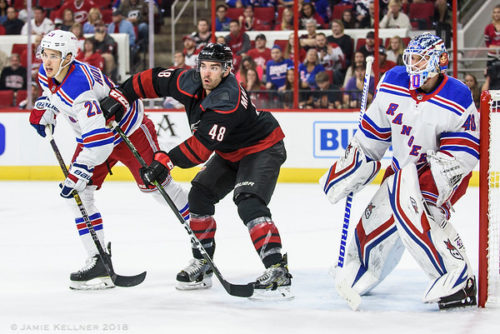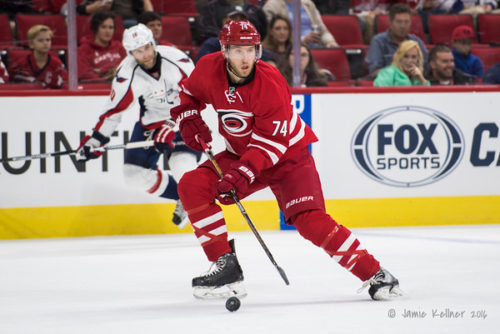I thought about doing some long step-wise lead up to the critical points of the 2017-18 Carolina Hurricanes season, but the the playoff-less streak at eight seasons and the sense of urgency increasing, I am instead going to lead with the important stuff and follow up with other details afterward.
An important starting point is recognizing that the nature of the NHL game especially in today’s day and age requires contributions from all 20 players on the roster. Even the #6 defenseman will play 13-15 minutes and will be targeted by opposing coaches making that role potentially make or break for any given game despite its ranking way down the depth chart. The backup goalie will not figure at all in a large number of games, but he is very clearly front and center for a large chunk of schedule estimated to be 25-30 games for the Hurricanes this season. And though the fourth line will usually see fewer minutes and might even get skipped in the rotation late in close games, those players often man the all-important penalty kill which sees the other teams’ best players with a good chance to score.
In addition to recognizing that all 20 players on the roster plus likely 4-7 more who see action because of injuries or search for a spark during a long NHL season, it is important to recognize that the next leg up for the Hurricanes requires players who have plateaued as productive players further in their careers to continue to perform at a similar level. The crux of this article focuses on young players who have the potential to take a significant step up from the 2016-17 season and push the team higher in the process. But the gains and move upward are only realized if the foundation of positives from the 2016-17 are replicated and do not crumble underneath any gains for 2017-18.
Disclaimers and context aside, here is my list of four players who are most on the spot in terms of having the potential to take a significant step forward that lifts the entire team from also ran up into the 2018 NHL playoffs.
The four pillars of the foundation
As noted above, to reach a higher level in 2017-18 will hopefully involve taking a couple strong foundations from the 2016-17 and building upon them.
I consider four returning players most critical to the foundation. I think all four players have upside from what they accomplished in 2016-17, but at the same time, I think if they can simply replicate their role, level of play and productivity from 2016-17, it will be enough.
Jeff Skinner
On a team that needs to push upward just to reach the league average for scoring, Jeff Skinner is critical. His ability to both create and finish his own scoring changes at an elite goal scoring level in today’s NHL helps build an offensive base. Skinner does not necessarily need to match or exceed his 37 goals in 2016-17, but if he is not at least close, it likely becomes challenging for the team to score enough.
Jordan Staal
So much is made of Jordan Staal’s scoring or lack of scoring. A few more goals would be welcome obviously, but at the end of the day, if Staal can continue to take the toughest of match ups and break even in those battles, that puts the ball on the tee for increasing scoring depth to be enough.
Jaccob Slavin and Brett Pesce
Jaccob Slavin and Brett Pesce were the foundation of the blue line in 2016-17. Whether playing together as a pure top pairing or separated to try to balance out two pairs, the young duo must be steady and solid. They too have scoring upside as young players, but if they simply replicate their steady defensive play from 2016-17, it would be enough.
Five (0r six) Hurricanes players with upside for charting a path higher
Scott Darling
Arguably, the weakest link for the Carolina Hurricanes in 2016-17 was its goaltending. Hurricanes general manager Ron Francis cut not corners and spared no cost (though he actually did not spend a ton) to get one of the two or three best options available on the goalie market during the offseason. Darling ranked near the top of everyone’s list along with free agent Ben Bishop and the possibility of using the expansion draft to obtain a recent #1B or #2 goalie with upside.
Credit to Ron Francis for assertively making a move to shore up the position.
But the goalie position is a fickle one that has seen one-time rising stars like Ryan Miller, Roberto Luongo, Pekka Rinne and the Hurricanes own Cam Ward go very quickly from rising star to struggling mightily. At a basic level of I put the probability of success for any goalie move at no greater than 60-70 percent (without even caring who the player is) simply because of the nature of the role and position.
So that is a long way of saying that just because Ron Francis went out and got his guy does not mean with certainty that it will all go according to plan.
The positive is that the baseline from the past couple years is low enough that the Hurricanes do not need Vezina contender-level play. The team simply needs to boost its play up to the league average or ideally a small bit above that, and that could be enough to push into the playoffs if enough things fall into place.
That task of boosting the goaltending to league average or better will include a dash of new goalie coach Mike Bales, also a significant helping of Cam Ward manning the net in a backup role and even Coach Bill Peters’ hand managing the position after a dicey 2016-17 season in that regard, but when push comes to shove, the challenge to boost the Hurricanes netminding falls squarely on the shoulders of Scott Darling. If he struggles to transition and get his feet under him fairly quickly, the Hurricanes will very quickly find themselves in a familiar uphill battle trying to defy the odds and outplay their netminding to push into the playoffs.
Noah Hanifin and/or Justin Faulk
People both local and out in the broader hockey world are in near unanimous that the future of the Carolina Hurricanes blue line looked very promising both heading into and during the 2016-17 season. For me, a noticeable issue was the interchangeable use of “will be” versus “is.” By my account, as promising as the Hurricanes defense was at the very top, namely Jaccob Slavin and Brett Pesce, it struggled through much of the season below that. Hainsey/Faulk had a tough time of it defensively especially on the road where opposing coaches preyed on the duo. And the third pairing that featured Noah Hanifin with a revolving door next to him was similarly problematic through two-thirds of the 2016-17 season. When you net it out, the defense kept its promise of a bright future intact but was not really there yet in 2016-17.
But after the departure of Ron Hainsey at the trade deadline, Noah Hanifin and Justin Faulk simultaneously found a higher gear and suddenly it looked like the promising future was in fact being realized.
Though the latest iteration of the lineup has them split, one or both of Hanifin and Faulk will need to play at the level he did in the last third of the 2016-17 season which is significantly higher than the previous part of the season.
Ideally, both players will step up and the Hurricanes will realize their future of having one of the elite blue lines in the NHL. But at a minimum, one of these two players must play at least at the level he did in the tail end of the 2016-17. If that does not happen, the prospect of trying to build even a serviceable defensive corps becomes challenging especially on the road. When the 2016-17 season died in the early part of winter last year, it was largely on the road with Peters trying to pull all kinds of levers to shore up the defense, but it just was not enough. Being solid four deep or at least 3 1/2 deep on the blue line is critical to taking the next step forward defensively.
I am on record as ranking Noah Hanifin at the top of my list for having a strong preseason and suggesting (admittedly against lesser competition) that he is ready to take the next step in his development. Here is hoping that his preseason play carries over and that he quickly establishes himself as a solid #3 (which would be enough) and maybe even starts pushing for consideration as a #2 or even #1 among a strong group.
Elias Lindholm
Sometime around December, a switch seemed to flip in Elias Lindholm. The impact on the score sheet was modest initially, but to those of us who track Hurricanes hockey on an every-game basis, the suddenness of Lindholm finding a higher gear in terms of physical engagement was unmistakable. He went from being a player who had long stretches of near invisibility during his first three and a half years in the NHL to a player who was noticeably physically engaged every shift. He played with an edge. He engaged the puck and opponents whenever possible. And most significantly, he finally showed glimpses of the Peter Forsberg bulldog-like comparisons from prior to and shortly after being drafted. Lindholm’s offensive production emerged more gradually but more significant was the fact that the Hurricanes had suddenly added another player who was difficult to play against.
I continue to like Lindholm next to Jordan Staal which makes up two-thirds of an elite checking line that can also chip in offensively. Reegardless of where in the lineup Lindholm plays, I think him finding that higher gear on an every shift basis in terms of intensity level and physical engagement is a key element for a Hurricanes lineup that leans skill over physical play. I put Lindholm a bit in the same category as Jordan Staal in that I worry less about scoring totals and instead focus on whether they are winning or breaking even in their battles against the other teams’ best players on a nightly basis.
Justin Williams
He does not fit the bill as a raw playmaker and scoring line catalyst which was my target for the offseason. But that is not to say that Williams is not a good player, nor even that he cannot help boost scoring. At a bare minimum, he adds additional scoring depth. But in preseason, he has been significantly more than that. He has played with a variety of lines and helped make different players better along the way. His game is not that of a flashy playmaker, but perhaps his brand of solid puck possession skills and heady play can subtly accomplish the same thing.
Williams as a ho-hum mid-40s depth scorer boosts the team slightly, but the Holy Grail is a scenario whereby Williams can help fuel a scoring line with two-way acumen to boot and provide a leader who changes the mentality from ‘playoffs soon’ to ‘playoffs now – it’s not if but how.’
I think Williams as much as any player on the team could be a rover throughout the lineup as Peters looks to accomplish different things, play match ups and find sparks when things go stale. If that proves to be correct, there is no 82-game set of line mates for Williams. That said, I would like to see him start the season opposite Teuvo Teravainen to see if he can help Teravainen find the higher gear that seems to be in his skill set at least partially through finding every-game consistency.
Sebastian Aho
After a significant commotion at the front part of the summer focused around adding a significant offensive piece, ideally to center a top scoring line, the offseason came and went rumors and rumblings but no actual deal. By no means do I wish to downplay the additions of Justin Williams and Marcus Kruger. Both improve the team, and Williams in particular will also improve the offense. But neither is the true catalyst that I thought the team needed and that Francis cryptically alluded to in his 2016-17 postseason interview.
Making the jump straight from playing in Finland to a top 9 forward role in the NHL, Aho had a mixed start. He collected a good number of assists, many on the power play, right out of the gate but did not notch his first goal until his 14th NHL game on November 12.
Important to note is that I put Sebastian Aho last on purpose because I think there are more potential alternatives and a greater potential to do it by committee. While I do think there are potential paths with another young player rising up, modest increases across the board being enough or even improved goaltending and defense being enough such that more scoring is not a necessity, I think the path to the playoffs becomes significantly easier if the team can find a player past Jeff Skinner who is capable of being a catalyst for a scoring line.
While there are other options, I think Sebastian Aho has the greatest chance to be a catalyst that boosts a scoring line and with it the entire team to a higher level offensively. Sebastian Aho had a very respectable 49 points in his rookie campaign. Virtually everyone sees that as a stepping stone on the way to more. Aho’s ability to both score more himself and equally importantly serve as a catalyst that helps boost the production of two line mates could be a critical component to a Hurricanes team that scores and is not forced to grind out 2-1 wins every night to rise in the standings.
Go Canes!




The pillars are exactly right.
Staal is not an elite scorer, but in other aspects of the game he is among the best. I think we as fans expect him to be elite defensively, win 55% or more of his face offs, and kick in with 15-20 goals and 25 assists. Fans expect it because he consistently delivers. Given that his line mates this year will either be better than in the past or at least further along in their careers, Staal should see modest offensive improvements.
Skinner will score. As you mentioned last week, given that he is likely to be on the “third” line he will see favorable matchups. If he plays 75+ games, he will have 30 goals and may challenge 40 again.
I am a big fan of Pesce and Slavin being on different pairings. They both elevate the play of all the other players on the ice, so to me it makes sense to include Faulk and Hanifin in the improved play (and I think playing alongside Pesce is part of the reason Hanifin looked more confident in the preseason). BP used them together on the PK and that makes sense. These two are the foundation for what is already the team’s greatest strength. As the year proceeds the 6 defensemen will be one of the top 3 D units in the league.
I am on record, and will repeat whenever given the chance, as saying Williams is the type of player the Canes needed. While he may not look the part of puck-carrying, fancy-passing playmaker, the statistics indicate that he is among the best in the league at transitioning the puck and “building up” scoring chances. In fact, according to the data that most analyzes a players’ overall impact (Ryan Stimson’s Player Types), Williams’ influence is that of a “playmaker.” Williams drives possession, wins puck battles, makes effective passes for dangerous shot opportunities–short of being a 75-point player, the Canes could not ask for more.
The comments yesterday included two interesting positions regarding Aho. One is that he will continue his pace from the last 2/3 of 16-17 and his numbers will challenge Skinner in total points and maybe goals. The other position was that Aho might have a bit of a sophomore slump due to the league determining how to better defend him. I am between those two positions. I think Aho’s numbers will look much like last season. I expect a slight uptick as the production will hopefully be spread throughout the year. My guess would be 25/53 or thereabouts. I believe that will be either third or fourth on the team in total points. Also, I believe Aho will be closer to 70 points on a regular basis starting in 18-19.
Jordan Staal- we brought in Kruger to give Staal more offensive faceoffs. I would expect an uptick in his offense as we putting him in a better position. His line scoring will be key to the success of the team.
As i was watching the preseason, Williams made every line he was on better. He will add 20 goals but more importantly get other guys scoring. I hope to see him with Rask early on because we need Rask to score. TT and Williams should get Rask going.
We need Rask to score more than Lindholm.
Darling is key. Just be a top 15 goalie. That is it, top 15.
Lots of great (well thought-out) ideas /analysis!
My thinking is pretty simple – if we score more, and give up less…WE WIN A LOT MORE!
Possession IS THE NAME OF THE GAME! AND, using our speed is how we accomplish that.
Preseason illustrated we can out skate teams…more shots-for…less shots-against! That template augers well for NOT LOSING! …and that means points, wins…..and playoffs?
YES!